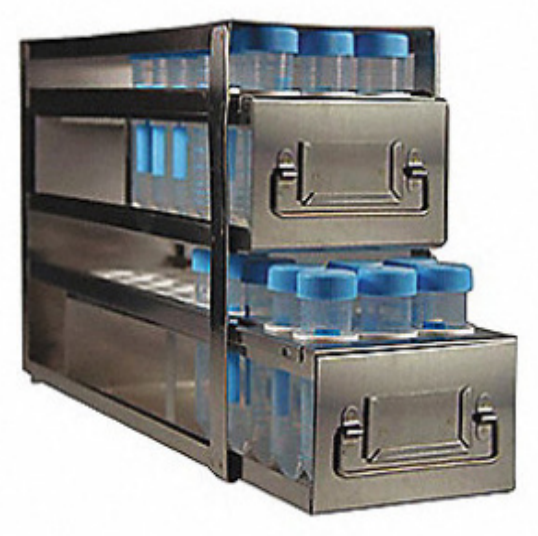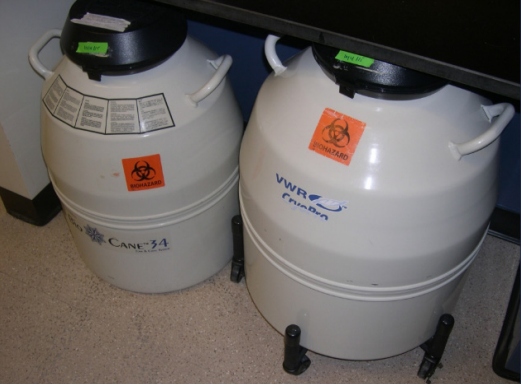All cultured biological material must be stored in closed containers (e.g., lidded plates, capped tubes, etc.). Lids/caps can be loosened enough to allow for maintenance of aerobic conditions as needed within the culture vessel, but must not be so loosely placed that they can fall off or be easily dislodged from vessel openings. Culture plates/tubes and their lids may be further secured with a parafilm seal, as needed.
All stored tubes (e.g., screw-cap tubes, snap cap plastic tubes, Eppendorf tubes, conical screwcap tubes, etc.) containing culture material must be secured in tube racks or boxes.
Racks/boxes of culture tubes must not be placed precariously on the bench or refrigerator/ freezer shelves; make sure they are solidly placed.
Stacks of stored culture plates must be secured in plate carriers, pans, or plastic sleeves with taped closures to prevent spillage.


All stored culture vessels must be legibly labeled with contents and date. If vessels are too small for full labeling, use a coding system and a log or record that coordinates each culture code with: 1) complete identity information for contents, 2) date, and 3) rack or box location of the culture, 4) name of researcher.
All refrigerators, freezers, and Dewars used for biohazard storage must be labeled with the universal biohazard symbol.

The University of Utah requires the installation of continuous monitoring devices or systems on all temperature controlled units, maintenance of an active inventory and report of estimated dollar value of materials: visit the Risk Management website for additional Information.
This type of freezer storage is essential for preserving valuable sample inventories in many labs. Most freezer models are equipped with alarms to warn of systems failure and warming interior temperatures. University of Utah policy requires that there must be a system by which the PI and/or lab manager are immediately notified of alarm conditions: visit the Risk Management website for additional Information.
Keeping a daily temperature log for any -80˚C freezer is highly recommended for quality assurance purposes, i.e., to monitor the range of daily fluctuations, for malfunctions/ error messages, and for trends of deteriorating performance. Hazards: The operating temperature of -80˚C (-112˚F) is capable of inflicting frostbite very quickly; skin must be protected from direct contact with surfaces at this temperature, especially metal surfaces, by using insulated gloves.
Chronic mishandling of these freezers can shorten their useful life and/or result in sudden operational failure, risking loss of irreplaceable samples.
The following guidelines are provided to avoid this outcome:
- • 80˚C freezers do not automatically defrost; in fact, ice builds up in them at a rate that requires defrosting with some regularity to avoid accumulations that will interfere with door closure. DO NOT FORCE DOOR CLOSURE OVER ICE BUILDUP; THIS CAN DEFORM THE DOOR AND HANDLE, MAKING THE UNIT INOPERABLE. In such a situation, immediate defrosting is called for rather than forcing closure.
- Ice buildup also can make sample retrieval challenging; be sure your samples are well organized and in well-labeled racks or boxes that are intended for -80˚C freezer storage.
- Keep a diagram of exactly where you store materials in the freezer so you can go right to what you need, as opposed to searching randomly with the freezer door open and allowing the contents to warm.
- OPEN FREEZER DOORS FOR THE MINIMUM TIME POSSIBLE, AND FOR THE MINIMUM NUMBER OF TIMES OF DAY POSSIBLE. Try to coordinate with coworkers to access freezer contents in one or two trips to avoid multiple freezer openings throughout the day. Each opening challenges the cooling capacity of a -80˚C freezer to recover its set temperature; the longer and more frequently freezers are open, the more challenge is imposed, which can compromise long-term function.
- Schedule a -80˚C freezer defrost procedure with plenty of lead time in which to plan where you can relocate your inventory. -80˚C storage space in labs is usually at a premium, so finding extra space to temporarily house your inventory may be difficult. NOTE: Holding -80˚C inventory in a -20˚C freezer space WILL NOT keep them adequately frozen. If you cannot find temporary -80˚C freezer space, holding inventory in loosely-lidded Styrofoam boxes with dry ice is an acceptable alternative, if you keep the dry ice well supplied.
- Expect the entire process to take two days.
- Wear appropriate PPE for this process: at a minimum gloves, lab coat and eye protection. Remove your inventory from the freezer in an organized way so that you can return it to the -80˚C in good order. Take advantage of this opportunity to cull any inventory that is no longer needed.
- When your inventory is secure elsewhere, power down the freezer and place a sign on it that warns others: “Out of Service – Defrosting in Progress – Unit Will Be Decontaminated for Biohazardous Materials by: (your name) Before Return to Service.”
- Prop the door open to let thawing begin; a floor fan blowing room air into the freezer increases thawing rate. Expect complete thawing to take at least 24 hours.
- DO NOT USE SHARP OBJECTS TO CHIP ICE OUT OF THE FREEZER TO HASTEN THE PROCESS – THIS CAN DO STRUCTURAL DAMAGE TO THE FREEZER. Place pans on the shelves to catch melting ice. If the freezer stores biohazardous material, add one part bleach to 9 parts melted ice, and after 20 minutes contact time discard the melt-water down lab sink with running water.
- Place pan(s) on floor to catch the majority of melt-water. Place paper towels under
the pan(s) and on floor around the freezer to catch and absorb any melt-water that
does not go into the pans. As towels get wet, discard them in solid biowaste for autoclaving
and replace them with dry towels. Decontaminate damp floor area with a freshly prepared
1:10 dilution of bleach or other appropriate disinfectant.

- When ice is gone, decontaminate interior and exterior surfaces of the freezer with a freshly prepared 1:10 dilution of bleach or appropriate disinfectant, and allow to dry fully. In order to protect stainless steel surfaces consider a quaternary ammonium disinfectant, such as Lysol No Rinse (Reckitt Benckiser), Conflikt (Decon Labs) and Fermacidal-D (Labotect). Wipe any corrosive disinfectant residue (e.g., bleach) off with distilled (not deionized) water.
- If accessible, clean dust and dirt off the exterior coils on the back of the freezer.
- Turn power on and allow freezer to come to temperature. Leave freezer empty for at least a day to ensure that it will attain and hold temperature before returning inventory to it. It is common for freezers to fail following an out-of-service period, so monitor carefully.
- Plan the re-installation of inventory carefully so that it can be accomplished in as few sessions as possible, and as quickly and orderly as possible.
- Keep close check on the freezer after inventory has been returned to ensure that freezer returns to set temperature and holds there.
Adapted from Virginia Tech Universtiy Guidnace
